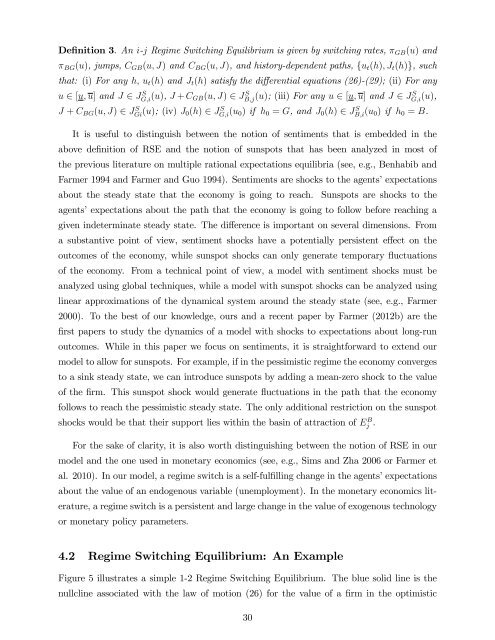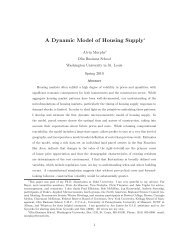Shopping Externalities and Self Fulfilling Unemployment Fluctuations*
Shopping Externalities and Self Fulfilling Unemployment Fluctuations*
Shopping Externalities and Self Fulfilling Unemployment Fluctuations*
You also want an ePaper? Increase the reach of your titles
YUMPU automatically turns print PDFs into web optimized ePapers that Google loves.
De…nition 3. An i-j Regime Switching Equilibrium is given by switching rates, GB (u) <strong>and</strong> BG (u), jumps, C GB (u; J) <strong>and</strong> C BG (u; J), <strong>and</strong> history-dependent paths, fu t (h); J t (h)g, suchthat: (i) For any h; u t (h) <strong>and</strong> J t (h) satisfy the di¤erential equations (26)-(29); (ii) For anyu 2 [u; u] <strong>and</strong> J 2 JG;i S (u), J + C GB(u; J) 2 JB;j S (u); (iii) For any u 2 [u; u] <strong>and</strong> J 2 J G;i S (u),J + C BG (u; J) 2 JGi S (u); (iv) J 0(h) 2 JG;i S (u 0) if h 0 = G, <strong>and</strong> J 0 (h) 2 JB;i S (u 0) if h 0 = B.It is useful to distinguish between the notion of sentiments that is embedded in theabove de…nition of RSE <strong>and</strong> the notion of sunspots that has been analyzed in most ofthe previous literature on multiple rational expectations equilibria (see, e.g., Benhabib <strong>and</strong>Farmer 1994 <strong>and</strong> Farmer <strong>and</strong> Guo 1994). Sentiments are shocks to the agents’expectationsabout the steady state that the economy is going to reach. Sunspots are shocks to theagents’expectations about the path that the economy is going to follow before reaching agiven indeterminate steady state. The di¤erence is important on several dimensions. Froma substantive point of view, sentiment shocks have a potentially persistent e¤ect on theoutcomes of the economy, while sunspot shocks can only generate temporary ‡uctuationsof the economy. From a technical point of view, a model with sentiment shocks must beanalyzed using global techniques, while a model with sunspot shocks can be analyzed usinglinear approximations of the dynamical system around the steady state (see, e.g., Farmer2000). To the best of our knowledge, ours <strong>and</strong> a recent paper by Farmer (2012b) are the…rst papers to study the dynamics of a model with shocks to expectations about long-runoutcomes. While in this paper we focus on sentiments, it is straightforward to extend ourmodel to allow for sunspots. For example, if in the pessimistic regime the economy convergesto a sink steady state, we can introduce sunspots by adding a mean-zero shock to the valueof the …rm. This sunspot shock would generate ‡uctuations in the path that the economyfollows to reach the pessimistic steady state. The only additional restriction on the sunspotshocks would be that their support lies within the basin of attraction of Ej B .For the sake of clarity, it is also worth distinguishing between the notion of RSE in ourmodel <strong>and</strong> the one used in monetary economics (see, e.g., Sims <strong>and</strong> Zha 2006 or Farmer etal. 2010). In our model, a regime switch is a self-ful…lling change in the agents’expectationsabout the value of an endogenous variable (unemployment). In the monetary economics literature,a regime switch is a persistent <strong>and</strong> large change in the value of exogenous technologyor monetary policy parameters.4.2 Regime Switching Equilibrium: An ExampleFigure 5 illustrates a simple 1-2 Regime Switching Equilibrium. The blue solid line is thenullcline associated with the law of motion (26) for the value of a …rm in the optimistic30
















